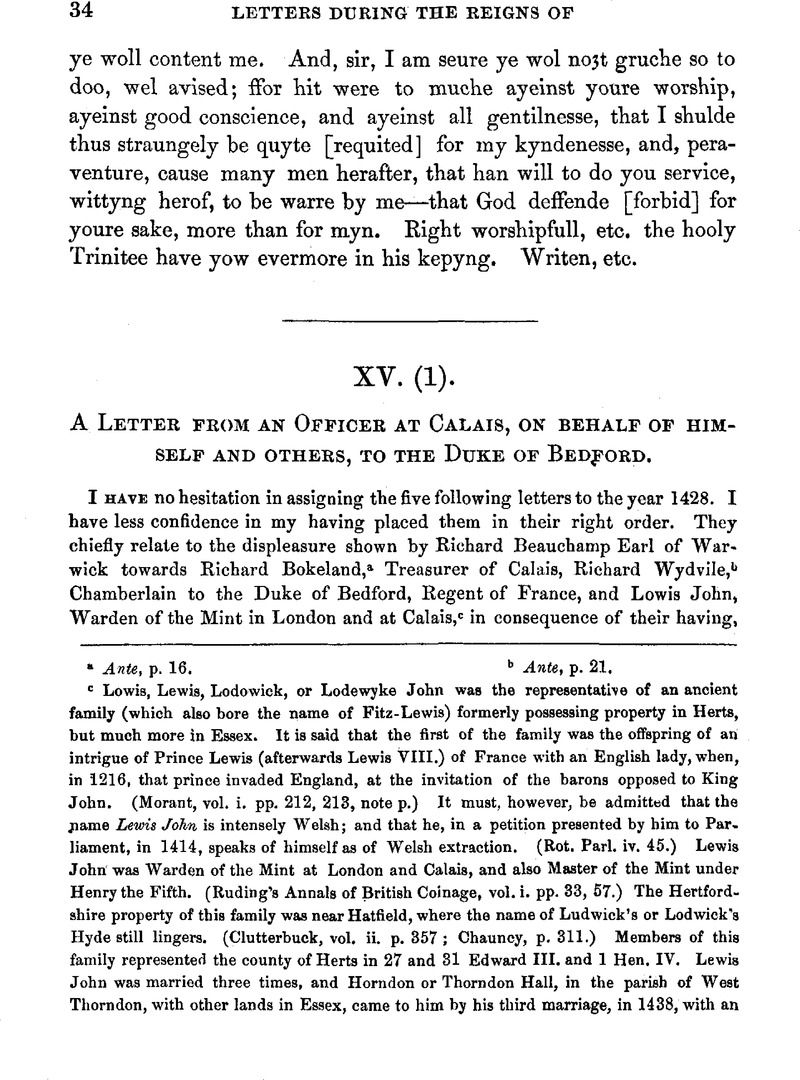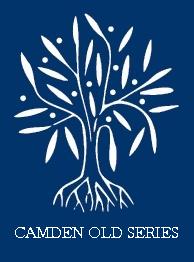No CrossRef data available.
Article contents
XV. (1). Letter from an Officer at Calais, on behalf of himself and others, to the Duke of Bedford
Published online by Cambridge University Press: 23 February 2010
Abstract

- Type
- Letters during the Regins of Henry V. and Henry VI
- Information
- Copyright
- Copyright © Royal Historical Society 1863
References
page 34 note a Ante, p. 16.Google Scholar
page 34 note b Ante, p. 21.Google Scholar
page 34 note c Lowis, Lewis, Lodowick, or Lodewyke John was the representative of an ancient family (which also bore the name of Fitz-Lewis) formerly possessing property in Herts, but much more in Essex. It is said that the first of the family was the offspring of an intrigue of Prince Lewis (afterwards Lewis VIII.) of France with an English lady, when, in 1216, that prince invaded England, at the invitation of the barons opposed to King John. (Morant, vol. i. pp. 212, 213, note p.) It must, however, be admitted that the name Lewis John is intensely Welsh; and that he, in a petition presented by him to Parliament, in 1414, speaks of himself as of Welsh extraction. (Rot. Parl. iv. 45.) Lewis John was Warden of the Mint at London and Calais, and also Master of the Mint under Henry the Fifth. (Ruding's Annals of British Coinage, vol. i. pp. 33, 57.) The Hertfordshire property of this family was near Hatfield, where the name of Ludwick's or Lodwick's Hyde still lingers. (Clutterbuck, vol. ii. p. 357; Chauncy, p. 311.) Members of this family represented the county of Herts in 27 and 31 Edward III. and 1 Hen. IV. Lewis John was married three times, and Horndon or Thorndon Hall, in the parish of West Thorndon, with other lands in Essex, came to him by his third marriage, in 1438, with an Essex heiress. (Magna Brit. Essex, p. 684.) He died in 1442. (Inquis. post mortem, 21 Hen. VI.)
page 35 note a Ry. x. 399; Rot. Parl. v. 411a; Acts of Privy Council, iii. 296; and Pat. 6 H. VI. p. 2, m. 5. The “Articles declaring how the Earl of Warwick took charge of Henry VI.” which Sir John Penn has prefixed to the Paston Letters, were not entered into on this occasion, but are of a later date (11 Hen. VI.).
page 35 note b Lobineau, Hist, de Bretagne, tom. i. p. 572.
page 35 note c Acta Regia, vol. ii. p. 244.
page 35 note d Hall, 143.
page 35 note e Lord Salisbury was mortally wounded at Orleans, but died at Meungsur-Loire, the 3rd November, 1428. Of him an old French author (Lefebre de St. Denis), quoted by a modern historian, writes thus: “Plus vaillant homme que lui ne fut en Angleterre, ni ne put être sous le soleil.” (Martin, Hist, de Prance, vii. 7, 41, 47, 48.)
page 35 note f Rot. Franc. 7 Hen. VI. m. 1.
page 35 note e Walter Lord Hungerford held high office under the Crown, during the reigns of Henry the Fourth, Henry the Fifth, and Henry the Sixth. He served in France under Henry the Fifth, received grants in that country, and was made a Knight of the Garter. He was also one of the King's executors. He was, for many years, Lord Treasurer of England, and sat in Parliament as Baron Hungerford from 4 Hen. VI. (1426) to 27 Hen. VI. (1449). He died in 1449, and was buried in Salisbury cathedral, (l)ugd. Bar. vol. ii. pp. 204, 205, 206.) Notwithstanding the minute directions given by this nobleman in his will (Test. Vet. vol. i. p. 257) as to his place of sepulture, scarcely a trace of it exists. Walter Lord Hungerford resided chiefly at Farley Castle, otherwise Farley Montford, on the borders of Wilts and Somersetshire. The remains of Farley Castle are said to be very trifling. (Hungerfordiana, , p. 102.)Google Scholar


